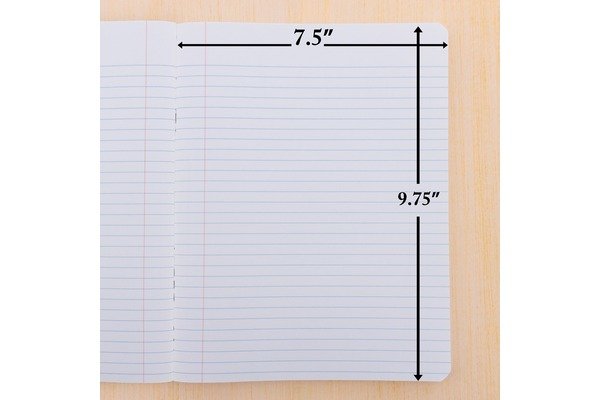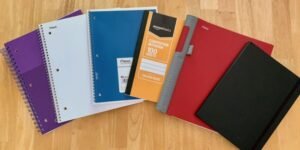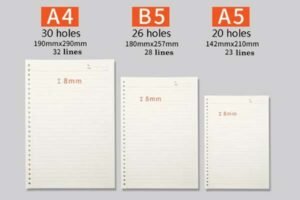
Are you trying to figure out notebook sizes1? It gets confusing fast, especially with terms like "composition notebook." You need the right size for your notes or projects, but the standards aren't always clear. Let's break down exactly what defines a composition notebook size.
A standard US composition notebook2 typically measures 9.75 inches tall by 7.5 inches wide (which is about 24.8 cm x 19.1 cm). This is the most common size you'll find for this type of notebook in the United States.
This specific size has become a classic, especially in American schools. Many of us used them growing up. The dimensions offer a good middle ground. It's large enough to write comfortably during a class or meeting, but it's also compact enough to fit easily into a backpack or tote bag without taking up too much space or bending easily.
You'll often find these notebooks with 100 sheets (that's 200 pages) of paper. The ruling inside is usually either wide ruled, often preferred by younger students, or college ruled, which has narrower lines suitable for older students and adults. And of course, there's the iconic black and white marbled cover, paired with a durable stitched binding down the spine – key features of the traditional composition book style.
Are Composition Notebooks the Same Size as Standard Notebooks?
You might pick up a composition notebook and wonder if it's just another "standard" size, like the printer paper you use. Let's clarify that common question.
No, composition notebooks (at 9.75" x 7.5") are definitely not the same size as standard US Letter paper (8.5" x 11"). They are also different from the international standard A4 paper (8.27" x 11.69"). Their dimensions make them unique.

Understanding these size differences is important when choosing a notebook. Here's a closer look:
Comparing Common Notebook Sizes
It helps to see the numbers side-by-side:
| Notebook Type | Dimensions (Inches) | Dimensions (cm) | Common Use Region |
|---|---|---|---|
| Composition | 9.75" x 7.5" | 24.8 x 19.1 cm | United States |
| US Letter | 8.5" x 11" | 21.6 x 27.9 cm | United States |
| A4 | 8.27" x 11.69" | 21.0 x 29.7 cm | International |
| B5 | 6.9" x 9.8" | 17.6 × 25.0 cm | International |
Note: B5 is another common size, especially popular in Japan and some European markets, sometimes mistaken for composition size due to similar width.
Why Size Differences Matter
The size impacts how you use the notebook.
- Writing Space: US Letter and A4 offer more writing area per page. This is useful for detailed notes or drawings.
- Portability: Composition notebooks are generally more portable. They fit well in bags and are less likely to get damaged corners compared to larger, more flexible notebooks.
- Compatibility: Standard US Letter or A4 notebooks often come hole-punched for binders. Traditional composition notebooks usually do not, as their sewn binding is part of their design. At NotebookRing®, we can customize hole punching, but it's not typical for the classic composition style.
A Note on Global Standards
Outside the US, the A-series paper sizes (A4, A5, A6) are the dominant standard, governed by ISO 216. The composition notebook size is primarily a US convention, though its popularity means it's recognized elsewhere too. Its dimensions don't neatly fit into the A or B series standards.
What Are the Benefits of the Composition Notebook Size?
So why has this specific, slightly unusual 9.75" x 7.5" size remained so popular for decades, especially in education?
The composition notebook's size strikes a practical balance between having enough writing space and being easy to carry. Its sturdy construction, with a sewn binding and stiff covers, also makes it very durable for everyday use.
Let's dive deeper into these advantages:
Built to Last
Composition notebooks are known for their toughness.
- Sewn Binding: Unlike spiral notebooks where pages can tear out easily, or glued notebooks that might fall apart, the sewn binding holds pages securely. At NotebookRing®, we pay close attention to binding strength in our quality control, often testing notebooks for durability through hundreds of page turns.
- Stiff Covers: The traditional cardboard covers protect the pages inside from getting bent or crumpled in a bag. This makes them reliable for students and professionals alike.
Easy to Carry
Their size is a major plus for portability.
- Bag-Friendly: They slide easily into backpacks, briefcases, or even larger purses without the awkwardness of a full Letter or A4 notebook.
- Handling: The size is comfortable to hold while writing, whether at a desk or balanced on your lap.
Comfortable Writing Experience
The dimensions lend themselves well to note-taking.
- Page Layout: The 7.5-inch width provides enough horizontal space for comfortable handwriting without feeling cramped.
- Flatness: While not perfectly flat like a spiral notebook initially, the sewn binding allows the notebook to lay reasonably flat once opened and used a bit, especially compared to thick, tightly glued notebooks.
Can I Customize the Size of Composition-Style Notebooks?
What if you love the sturdy feel and sewn binding of a composition book, but the standard 9.75" x 7.5" size isn't quite right for your needs?

Yes, customization is possible. While traditional composition notebooks stick to the standard size, manufacturers like us at NotebookRing® can create notebooks inspired by the composition style but in custom dimensions and with various features.
This opens up possibilities if the standard size doesn't fit your specific project or brand.
Your Customization Options
When you work with a manufacturer like NotebookRing®, you can often adjust several elements:
- Dimensions: Need something slightly taller, wider, or perhaps square? We can often accommodate custom size requests, within manufacturing limits.
- Cover: You're not limited to the black and white marble! We can do solid colors, use kraft paper, textured paper, or even PU leather. We also offer cover processes like hot stamping, laser engraving, or embossing to add logos or designs (these add a small cost per unit, like $0.08-$0.15).
- Paper: Choose the paper weight (e.g., standard 80gsm, smoother 100gsm, or even specialty papers) and ruling (lines, grid, dots, blank). We even offer eco-friendly options like recycled paper or bagasse fiber covers. Page numbering is also an option.
- Binding: While sewn binding is classic for this style, we can discuss variations if needed for specific functions.
Considering Order Quantity
Keep in mind that customization usually involves minimum order quantities (MOQs).
- Why MOQs? Setting up machinery for a custom size or design takes time and resources. MOQs ensure the production run is efficient.
- Flexibility: At NotebookRing®, we try to be flexible. We can sometimes start basic custom orders (standard materials, simple design changes) around 100 units. For more complex customizations involving unique materials or sizes, the minimum might be closer to 500 units. This allows smaller businesses or projects access to custom products. We even helped a Singapore gift company with monthly orders of just 300 sets.
When Custom Sizes Make Sense
Customizing composition-style notebooks is great for:
- Corporate Branding: Creating notebooks in company colors with a logo for employees or events. We did this for a Silicon Valley tech company, creating a unique onboarding gift.
- Specific Educational Needs: Schools might need a particular size for specific subjects or year levels.
- Retail Products: Designers or brands can create unique journal sizes that stand out on shelves. We worked with a Japanese brand on a special notebook size optimized for washi tape users.
- Gifts and Promotions: A custom-sized notebook feels more special and tailored.
Need Custom Notebooks? Partner with NotebookRing®
Hi, I'm Timothy Wei, General Manager at NotebookRing®. Since 2006, my team and I have dedicated ourselves to crafting high-quality notebooks and binders right here in Wenzhou, China. We understand the details matter, whether it's getting the size just right or ensuring the binding lasts.

We manage the entire process in-house, from processing special papers to stamping metal parts in our own workshops. This gives us great control over quality and allows us to offer truly custom solutions. Here’s what working with us looks like:
- ✅ Full Production Control: We oversee everything from raw materials to the finished product.
- ✅ Flexible Customization: We support sample orders starting from just 100 books for basic versions, scaling up for larger runs.
- ✅ Quality Craftsmanship: We blend traditional techniques with innovations, like our patented "seamless coil" for spiral options.
- ✅ Eco-Conscious: We hold FSC™ certification (C106904), offer recycled materials, soy ink, and even donate a sapling for every 100 books sold.
Whether you need thousands of notebooks matching specific school requirements, like our German chain bookstore client, or a few hundred high-end branded sets for corporate gifts, like the ones we made for a Silicon Valley firm, we can help. We offer design assistance, a wide range of material choices (including metal ring binders), and global shipping options (including DDP).
Ready to create the perfect notebook?
Contact us today!
- Timothy Wei | General Manager
- info@notebookring.com
- www.notebookring.com (Available in English, Chinese, Japanese)
Ask for our free physical sample book (with 20+ material samples) and an OEM proposal. We promise a response to your inquiry within 24 hours.
Conclusion
In summary, the standard US composition notebook size is 9.75" x 7.5". This size is distinct from US Letter or A4 paper. It remains popular due to its durability and portability, but custom sizes and styles are definitely achievable with manufacturers like NotebookRing®.





